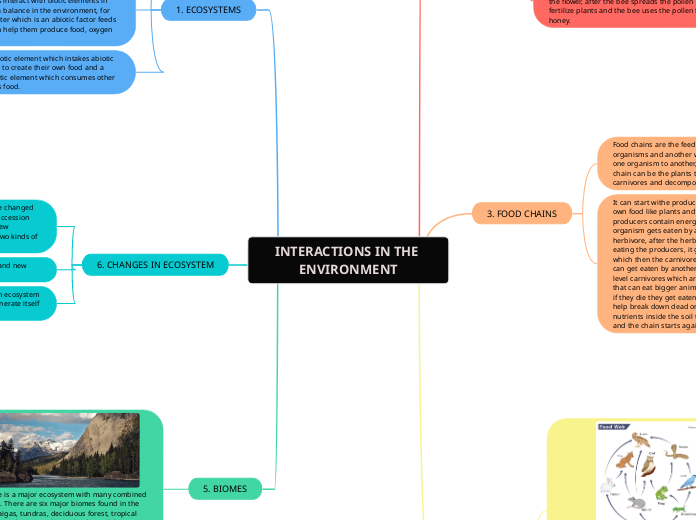INTERACTIONS IN THE ENVIRONMENT
2. SYMBIOSIS
Symbiosis is the relationship between two elements. there are three types of symbiosis
Parasitism only benefits one organism and harms the other organism. The one who benefits is the parasite and the host is the one who gets harmed, for example mosquitoes bite humans to make babies and humans get marks from them which can be itchy.
Commensalism benefits one organism but it does not affect the other one, for example a bird built its nest on the branch of the tree, but the tree does not get affected.
Mutualism is the interaction where it benefits both of the organisms, for example the bee is pollinating the flower, after the bee spreads the pollen to fertilize plants and the bee uses the pollen for honey.
3. FOOD CHAINS
Food chains are the feeding relation between one organisms and another which passes energy from one organism to another, at the bottom of the chain can be the plants then at the top can be carnivores and decomposers.
It can start withe producers which can make their own food like plants and these food created by producers contain energy, then the producer organism gets eaten by a consumer which can be a herbivore, after the herbivore gets the energy from eating the producers, it gets eaten by a carnivore which then the carnivore receives the energy an can get eaten by another carnivore which are high level carnivores which are really strong carnivores that can eat bigger animals like lions or tigers and if they die they get eaten by decomposers which help break down dead organisms which releases nutrients inside the soil that can help plant growth and the chain starts again.
4. FOOD WEBS
A food web is complex network of food chains in a food chain if two consumers consume one thing then they are part of the same food web and it shows many organisms that each organism consume, many food webs vary depending on the ecosystem.
We can say in the arctic, we can say since the polar bear and sea lion both eat fish. they are part of the same food web which means both polar bear and sea lions are connected to the fishes in the food web. which means that a food web connectes many food chains in one ecosystem.
1. ECOSYSTEMS
A n ecosystem is a group of abiotic and biotic elements which help each other to create a thriving environment, for example the forest is an example of an ecosystem.
Abiotic means non-living like soil and water. Biotic is the opposite of Abiotic even if dead or not. Abiotic elements interact with biotic elements in order to create a balance in the environment, for example the water which is an abiotic factor feeds the plants which help them produce food, oxygen and etc.
A producer is a biotic element which intakes abiotic elements in order to create their own food and a consumer is a biotic element which consumes other biotic elements as food.
6. CHANGES IN ECOSYSTEM
Ecosystems changes slowly, they can be changed by pollution, they can be changed by succession which means the gradual growth of a new organism in an environment there are two kinds of it.
Primary succession happens when a brand new ecosystem begins to grow.
Secondary succession happens when an ecosystem has been wiped our and begins to regenerate itself and start a new one.
5. BIOMES
A biome is a major ecosystem with many combined habitats. There are six major biomes found in the world, taigas, tundras, deciduous forest, tropical rainforests, dessert and grasslands. each biome has different interactions, climate and precipitation. for example, tundras has a really cold climate that really little plants ever grow or bloom there, they are found up north.
